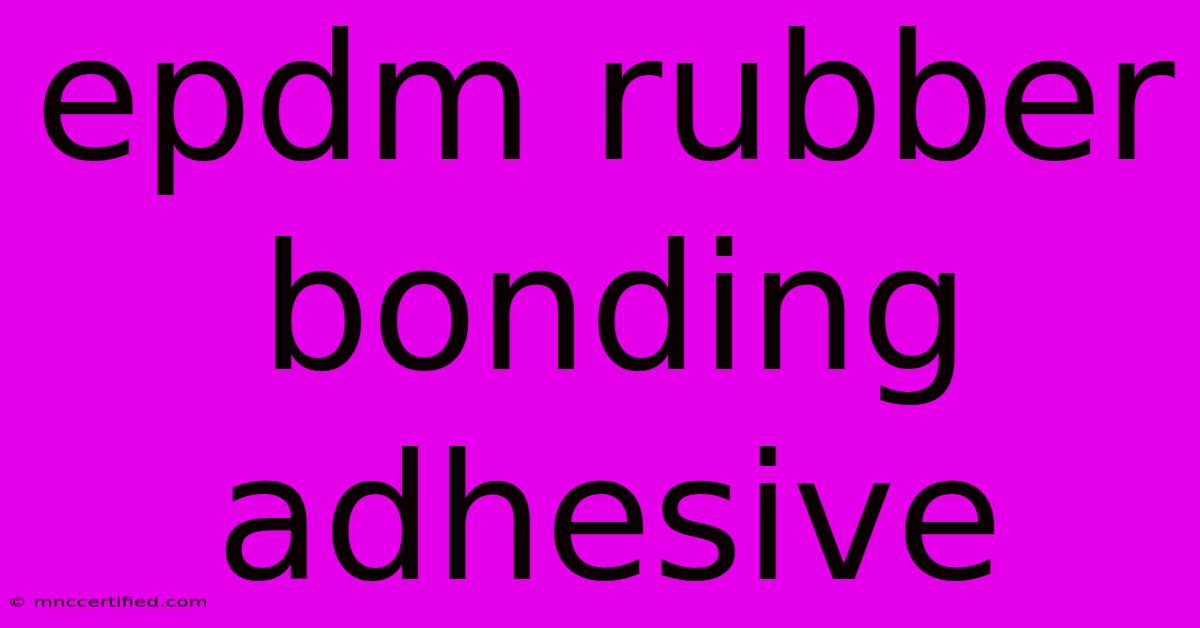Epdm Rubber Bonding Adhesive

Table of Contents
EPDM Rubber Bonding Adhesive: A Comprehensive Guide
Choosing the right adhesive is crucial for any EPDM rubber roofing project. A strong, durable bond ensures the longevity and effectiveness of your roof, protecting your investment for years to come. This guide delves into the world of EPDM rubber bonding adhesives, exploring their types, applications, and the factors to consider when selecting the best one for your needs.
Understanding EPDM Rubber and its Adhesive Needs
Ethylene Propylene Diene Monomer (EPDM) rubber is a popular roofing material known for its exceptional weather resistance, flexibility, and longevity. However, its inherent properties require a specialized adhesive to ensure a reliable and long-lasting seal. Standard construction adhesives often fail to provide the necessary strength and durability for EPDM, leading to leaks and premature roof failure. Therefore, selecting a high-quality EPDM rubber bonding adhesive is paramount.
Key Properties of a Good EPDM Adhesive:
- Strong Bond Strength: The adhesive must create a robust bond that can withstand the stresses of expansion and contraction caused by temperature fluctuations.
- Weather Resistance: The adhesive should be resistant to UV radiation, moisture, and extreme temperatures to prevent degradation and maintain bond integrity.
- Flexibility: EPDM rubber expands and contracts with temperature changes. The adhesive must remain flexible to accommodate these movements without cracking or breaking the bond.
- Fast Curing: A quicker curing time minimizes project downtime and allows for faster completion.
- Ease of Application: The adhesive should be easy to apply, ensuring a consistent and even bond across the entire surface.
Types of EPDM Rubber Bonding Adhesives
Several types of adhesives are specifically designed for EPDM rubber bonding. The best choice depends on factors like the substrate, application method, and environmental conditions.
1. Contact Adhesives:
Contact adhesives are popular for their strong initial tack and quick bonding time. They require applying adhesive to both surfaces, allowing it to flash off slightly before pressing the surfaces together. This method is efficient for large areas but requires precision and speed. Choosing a contact adhesive specifically formulated for EPDM is crucial for optimal results.
2. Primer-Based Adhesives:
Primer-based adhesives often require a separate primer application to the surfaces before applying the adhesive. This enhances adhesion, especially on difficult substrates. Primers help to clean and prepare the surface, improving the bond’s overall strength and durability. They're particularly useful for porous surfaces or when achieving maximum bond strength is vital.
3. Solvent-Based vs. Water-Based Adhesives:
The choice between solvent-based and water-based adhesives hinges on several factors, including environmental concerns and application conditions. Solvent-based adhesives often provide stronger initial bonds and better resistance to harsh weather, but they have stronger fumes and require more careful handling. Water-based adhesives are environmentally friendlier, with lower VOC emissions, but might offer slightly less bond strength in certain situations.
Choosing the Right EPDM Rubber Bonding Adhesive: Factors to Consider
Several critical factors influence the selection of the most suitable EPDM rubber bonding adhesive:
- Substrate Material: The surface to which the EPDM is being bonded (e.g., metal, wood, concrete) impacts the adhesive's choice.
- Environmental Conditions: The adhesive's performance needs to match the climate, considering factors like temperature extremes, UV exposure, and moisture levels.
- Application Method: The adhesive's application method (brush, roller, spray) needs to suit the project's scale and complexity.
- Project Requirements: The project's specific needs—like the required bond strength, curing time, and overall longevity—must guide the adhesive selection.
Application Techniques and Best Practices
Proper application is crucial for achieving a strong and lasting bond. Always follow the manufacturer's instructions meticulously. This typically involves surface preparation, adhesive application, and curing time. Consider using appropriate safety equipment like gloves and eye protection, especially when working with solvent-based adhesives.
Maintaining Your EPDM Roof
Regular maintenance plays a crucial role in extending the lifespan of your EPDM roof and the integrity of its adhesive bonds. Regular inspections can identify potential issues early on, preventing costly repairs down the line.
Conclusion: Securing a Long-Lasting EPDM Roof
Selecting the correct EPDM rubber bonding adhesive is a critical step in ensuring a robust, long-lasting, and leak-free roof. Understanding the different types of adhesives, their properties, and the factors influencing your choice empowers you to make an informed decision that protects your investment and guarantees peace of mind. Remember to always consult the manufacturer's instructions for specific application details and safety precautions.
Keywords: EPDM rubber bonding adhesive, EPDM adhesive, rubber roofing adhesive, contact adhesive EPDM, primer-based adhesive EPDM, solvent-based EPDM adhesive, water-based EPDM adhesive, EPDM roof repair, EPDM roofing, roofing adhesive, EPDM sealant.

Thank you for visiting our website wich cover about Epdm Rubber Bonding Adhesive. We hope the information provided has been useful to you. Feel free to contact us if you have any questions or need further assistance. See you next time and dont miss to bookmark.
Featured Posts
-
Martin Frizells Words On Fiona Phillips Health
Nov 29, 2024
-
Acceptance Insurance Lee Road
Nov 29, 2024
-
Nfls John Madden Thanksgiving Patches
Nov 29, 2024
-
Ariana Madix Performs Lovefool Live
Nov 29, 2024
-
Matchday Clements Starting Xi
Nov 29, 2024